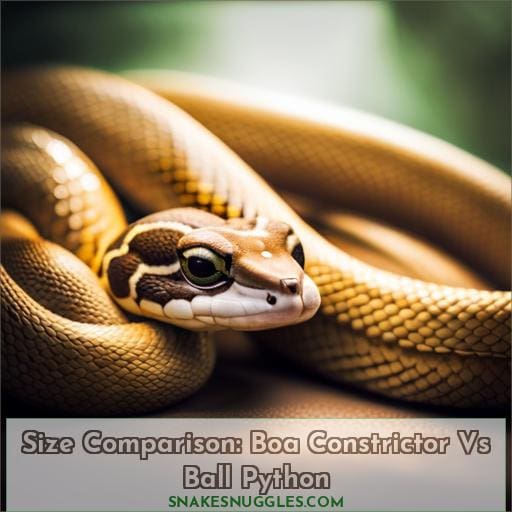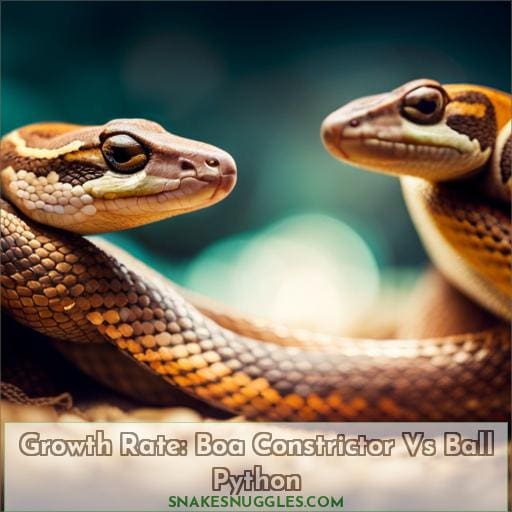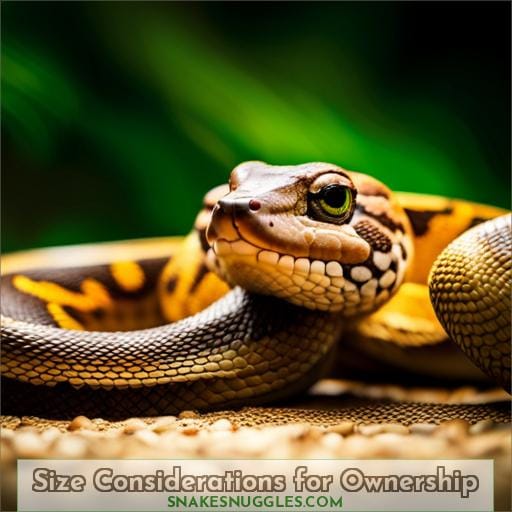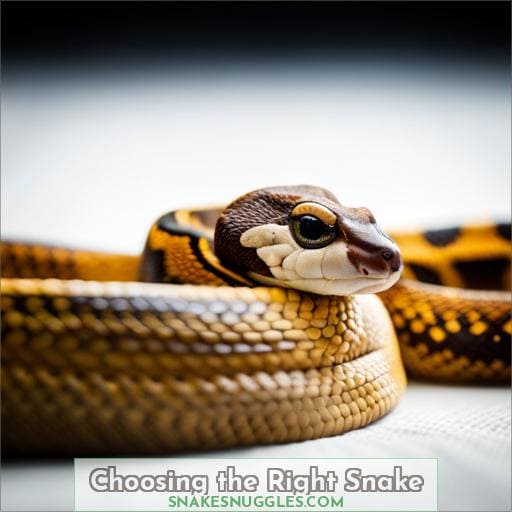This site is supported by our readers. We may earn a commission, at no cost to you, if you purchase through links.
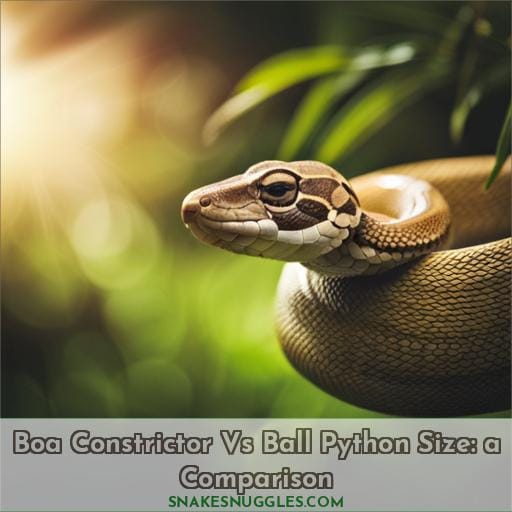
From average sizes to growth rates, we’ll analyze various factors that influence their dimensions. By understanding these distinctions, you can gain a greater sense of control when deciding which snake is right for you.
Table Of Contents
- Key Takeaways
- Size Comparison: Boa Constrictor Vs Ball Python
- Growth Rate: Boa Constrictor Vs Ball Python
- Size Considerations for Ownership
- Handling and Interactions
- Choosing the Right Snake
- Frequently Asked Questions (FAQs)
- How do the temperaments of boa constrictors and ball pythons compare?
- What are the pros and cons of owning a boa constrictor vs. a ball python?
- How much does it cost to care for a boa constrictor or a ball python?
- What size enclosure do boa constrictors and ball pythons need?
- What is the lifespan of a boa constrictor or a ball python?
- Conclusion
Key Takeaways
- Boa constrictors are typically larger in size compared to ball pythons.
- Factors such as genetics, environment, feeding habits, age, and overall health influence the size differences between the two species.
- Boa constrictors have a wider range of size potential, with the largest recorded size being over 14 feet.
- Ball pythons are generally smaller in size, with the largest recorded size being around 6 feet.
Size Comparison: Boa Constrictor Vs Ball Python
When comparing the size of a Boa Constrictor to that of a Ball Python, there are some notable differences.
On average, Boa Constrictors tend to be larger than Ball Pythons in terms of length and weight.
Factors such as species variation and individual growth rates can influence these size differences between the two snakes.
Average Size of Boa Constrictor
When comparing the average size of a Boa Constrictor to that of a Ball Python, it’s important to note that the former typically grows larger.
The average size of a Boa Constrictor can vary based on several factors such as:
- Growth factors
- Habitat influences
- Age considerations
- Species variances
These factors collectively determine how big an individual boa constrictor will grow and highlight the environmental impact on their physical characteristics for reptile enthusiasts to consider.
Average Size of Ball Python
The average size of a Ball Python, in comparison to the Boa Constrictor, is significantly smaller. While Boa Constrictors can reach lengths of 6-10 feet on average, Ball Pythons typically range from 3-5 feet in length.
This difference in size makes Ball Pythons more manageable for those with limited space or who prefer a smaller snake. However, it’s important to note that individual snakes within each species may vary slightly in size.
Boa Constrictor
Average Length: 6-10 feet
Largest Recorded Size: Over 14 ft.
Ball Python
Average Length: 3-5 feet
Largest Recorded Size: Around
6 ft.
The boa constrictor (Boa constrictor), also called the red-tailed boa or common boas,
In contrast,
the ball python (Python regius)
Factors Influencing Size Differences
To understand the factors that contribute to size differences between Boa Constrictors and Ball Pythons, it’s important to consider various aspects of their biology and development.
Genetic influences play a role in determining the potential growth rate of each species.
Environmental factors such as habitat conditions and availability of food can also impact their size.
Additionally, feeding habits, age, and overall health considerations can affect how large these snakes grow over time.
Growth Rate: Boa Constrictor Vs Ball Python
When comparing the growth rates of Boa Constrictors and Ball Pythons, it’s important to consider several factors.
Both species have different growth patterns and can reach varying sizes depending on their genetics, diet, and overall care.
Understanding these factors will give you a better idea of how quickly each species will grow and what to expect as they develop.
Growth Rate of Boa Constrictor
To understand the growth rate of a Boa Constrictor, you need to carefully observe its development over time.
Boas go through distinct growth stages, starting as hatchlings and gradually increasing in size.
Environmental influences such as temperature and humidity can impact their growth rate.
Additionally, a boa’s diet plays a crucial role in determining how quickly it grows.
Proper handling considerations are also important for ensuring healthy growth and overall well-being of this snake species compared to Ball Pythons.
Growth Rate of Ball Python
To understand the growth rate of a ball python compared to that of a boa constrictor, it’s important to consider their individual characteristics and development.
Here are four key factors regarding the growth rate of ball pythons:
- Weight Gain: Ball pythons experience steady weight gain throughout their lives.
- Feeding Frequency: They typically require weekly feedings on appropriately sized prey.
- Growth Spurts: Ball pythons may go through periods of rapid growth followed by slower phases.
- Adult Size: On average, ball pythons reach an adult size between 3-5 feet in length.
Understanding these aspects can help snake enthusiasts better care for and monitor the growth progress of their beloved ball python companions.
Factors Influencing Growth Rate
When considering the growth rate of Boa Constrictors and Ball Pythons, there are several factors that influence their development.
These factors include enclosure size, temperature, humidity, feeding frequency, and genetics.
The size of their enclosures plays a crucial role in providing them with enough space to grow properly.
Temperature affects their metabolism and digestion processes while humidity is important for shedding.
Feeding frequency varies between the two species as well.
Additionally, genetic factors can also impact the growth rate of both Boa Constrictors and Ball Pythons.
| Factors | Influencing Growth Rate |
|---|---|
| Enclosure Size | Provides adequate space for growth |
| Temperature | Affects metabolism and digestion |
| Humidity | Essential for proper shedding |
| Feeding Frequency Varies depending on species | |
| Genetics Can influence overall growth rate |
Size Considerations for Ownership
When considering boa vs. ball python ownership, it’s important to consider the size of each species.
Boa constrictors can grow up to 10 feet long, while ball pythons typically reach a maximum of 5 feet. This means that boa constrictors will require a larger enclosure than ball pythons.
You’ll also need to take into account the handling and enclosure setup when making your decision.
Space Requirements for Boa Constrictor
Boa constrictors grow to be much larger than ball pythons, so you’ll need to provide an enclosure that’s:
- At least 4 feet long
- 2 feet wide
- 2 feet high
for an adult. You should also provide a secure lid to prevent your snake from escaping.
Space Requirements for Ball Python
How much space does a ball python need?
A ball python’s minimum enclosure size is 50+ gallons.
Other considerations for ball python habitat include:
- Humidity requirements (50-80%)
- Temperature requirements (hot spot 90°F)
- Feeding frequency (adult boas may eat one jumbo rat/month)
Boas may be cheaper to keep due to less frequent feeding.
Considerations for Handling and Enclosure Setup
When deciding between owning a Boa Constrictor or a Ball Python, it’s important to not only consider space requirements but also take into account handling techniques and proper cage setup for each snake species.
Boa constrictors generally require larger enclosures compared to ball pythons, which thrive in a properly set up ball python enclosure, due to their bigger size potential. A spacious environment ensures that these large-bodied serpents have enough room for movement, reducing stress levels.
Temperature range is crucial in maintaining optimum health conditions within an enclosure for both boa constrictors and ball pythons alike. The hot spots should ideally reach around 90°F while ambient temperatures should hover around 80°F.
Temperature gradients are essential so that reptiles can thermoregulate effectively by moving from warmer areas during digestion periods.
Humidity levels must be carefully monitored as well; approximately fifty percent humidity works well under normal circumstances but increases up until seventy percent during shedding cycles. Humidity preferences slightly vary among individuals; some boas tolerate higher humidity ranging from sixty-eighty percent.
If keeping tarahumara boas, it’s important to note that they can tolerate colder temperatures compared to other boa constrictor subspecies.
Feeding frequency varies between the two species as well. Boa constrictors are known for consuming larger meals such as rabbits when they reach adulthood. Feeding frequency drops significantly with adult boas consuming one jumbo rat per month.
On the other hand, ball pythons should be fed weekly with appropriately sized rats or mice.
Handling and temperament differ among individual snakes; some boas may display a more friendly nature while others might grumble when taken out. Ball pythons generally exhibit a more placid disposition but there are exceptions in both species.
It is crucial to spend time observing their behavior and handling them properly according to their personality traits.
Considering all these factors alongside space requirements will help you make an informed decision regarding which snake – either boa constrictor or ball python – suits your preferences, lifestyle, and level of commitment.
Remember that owning either of these reptiles requires financial responsibility due to housing costs and feeding throughout its lifetime.
Handling and Interactions
When it comes to handling, both the Boa Constrictor and Ball Python have their own unique characteristics.
Boas are generally friendly and can be quite docile with regular interaction, although some may grumble when taken out of their enclosures.
On the other hand, Ball Pythons can exhibit more cautious behavior and may be iffy about cage openings.
Understanding these differences in temperament is crucial for ensuring a positive interaction with your pet snake.
Handling of Boa Constrictor
When handling a Boa Constrictor, you should be mindful of their size and strength.
These snakes can grow to impressive lengths, so it’s important to have the proper enclosure and space for them.
Boas are generally friendly in temperament but may grumble when taken out of their enclosure.
They require regular feeding, usually one jumbo rat per month for adults.
Providing the right humidity and temperature levels is crucial for their overall well-being.
Handling of Ball Python
Handling a ball python is similar to handling a boa constrictor, but there are some key differences you should be aware of.
- Ball pythons are more nervous and bitey than boas.
- Ball pythons should be hand-fed more frequently than boas.
- Ball pythons have a more docile temperament than boas.
- Ball pythons are easier to identify than boas.
Differences in Temperament and Behavior
Boa constrictors and ball pythons have different temperaments and behaviors.
Boas are more docile, while ball pythons can be feisty.
Boas prefer warmer temperatures and eat less frequently than ball pythons.
Both snakes require a large enclosure and community support.
Choosing the Right Snake
When choosing between a boa constrictor and a ball python, there are a few factors to consider, such as:
- Size
- Personal preferences
- Individual needs
Boa constrictors are larger snakes and require more space, while ball pythons are smaller and more manageable.
Factors to Consider When Choosing Between Boa Constrictor and Ball Python Based on Size
Based on their size, there are several factors to consider when choosing between a Boa Constrictor and a Ball Python.
- Feeding frequency
- Enclosure size
- Humidity and temperature requirements
- Cost of ownership
- Temperament and handling
Personal Preferences and Individual Needs
When choosing between a Boa Constrictor and a Ball Python, it’s important to consider your personal preferences and individual needs.
Factors to consider include:
- Feeding preferences
- Temperament
- Enclosure size
- Cost
Frequently Asked Questions (FAQs)
How do the temperaments of boa constrictors and ball pythons compare?
Ball pythons are more placid than boas, but both species have docile and feisty individuals.
Boas are slightly more skittish when young, but they calm down with age.
What are the pros and cons of owning a boa constrictor vs. a ball python?
When considering a boa constrictor vs. a ball python, it’s essential to weigh the pros and cons.
Boas offer size and presence while pythons are more manageable.
Both require proper care for their long lifespans.
How much does it cost to care for a boa constrictor or a ball python?
To care for a boa constrictor or ball python, you’ll need to consider the costs of housing and feeding throughout their 20+ year lifespan.
Boas may be cheaper due to less frequent feedings.
What size enclosure do boa constrictors and ball pythons need?
To provide the ideal habitat, boa constrictors and ball pythons require enclosures that mirror their natural environments.
Boas need larger spaces to roam freely, while pythons thrive in 50+ gallon tanks.
Choose wisely to satisfy their primal desires for freedom and control.
What is the lifespan of a boa constrictor or a ball python?
Boa constrictors and ball pythons can live 20+ years with proper care. Both species require a long-term commitment in terms of housing, feeding, and overall maintenance.
Understanding their lifespan is crucial when considering them as pets.
Conclusion
Now that you have a better understanding of the boa constrictor vs ball python size, you can make an informed decision about which snake is right for you.
Keep in mind that size is just one factor to consider when choosing a pet snake. Other important factors include:
- Temperament
- Handling
- Enclosure requirements

